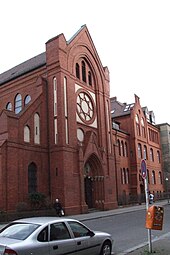Lietzow (Charlottenburg)
Lietzow (since the 18th century: Lützow ) was a place in the area of today's Berlin district Charlottenburg on the south bank of the Spree between today's Ernst-Reuter-Platz and Charlottenburg Palace , north of Otto-Suhr-Allee .
history
Early to the 15th century
This area was already inhabited in the Neolithic . In the area of today's Alt-Lietzow, experts found over 100 burial urns from the Bronze Age in 1881 , which indicate a larger settlement. The place was first mentioned as Lucene in 1239 . Like the Casow farm on the other bank of the Spree, it was probably a Germanic - Slavic mixed settlement that controlled the course of the river between Berlin and Spandau . The place Lietzow was a round village with a size of 29 hooves .
1315 acquired the St. Marien nunnery in Spandau Lietzow and Casow. In 1375 it appeared as Lusze , Luze , Lutze in the land book of Charles IV with a size of only 13 hooves, on which there were six Kötterhöfe . In 1450 the size of the village and the number of residents were confirmed again; Mentioned in 1465 as bey der Lutzen . In 1480, two kötter were added, so that there were now eight farms with the same number of hooves.
16th and 17th centuries
In 1590 there was a Lehnschulzengut in Luetze that was three hooves in size. However, the Schulzen did not have to pay any taxes for one of these hooves; it was free. The village school authority in Lietzow was owned by the Berend family for 400 years. There were also five two-hoofed animals, eight kötter "with a lot of land and meadow wax in the field" and several shepherds. For the first time the statistics reported that the village of Lietzow borders on the "City of Cölln, Schönenberg, Wilmersdorf and (on the) electoral heath". The monastery was abandoned with the beginning of the Reformation . Ecclesiastically the place belonged to the parish of Wilmersdorf . From 1688 a three-hoofed, five two-hoofed, eight kötter and one shepherd were known. The area was still 13 hooves in size; 36 people lived there. In 1695, Elector Friedrich III. von Prussia gave his wife Sophie Charlotte the place Lietzow in exchange for their country seat Caputh . She commissioned the master builder Johann Arnold Nehring to build a baroque summer palace west of the town. The building, completed in 1699, was called "Lützenburg". Later, when the couple had achieved royal dignity, they decided to expand it in a representative way.
18th to 21st century
The palace and the settlement immediately next to it were given the name Charlottenburg in 1705 after the queen's death. In 1711 there were six Hufner, eight inhabited Kötterhöfe, a shepherd and a servant. They paid three groschen for each of the 13 hooves and thus comparatively little taxes, because "most of the field had been taken from the community". Lietzow was finally incorporated in 1719 and subsequently grew structurally together with Charlottenburg.
In the 21st century, practically nothing has been preserved from the historical structure of the place. The old streets around the Anger are now off the main thoroughfare, Otto-Suhr-Allee, in the shadow of the Charlottenburg town hall . The medieval village church originally standing on the green was replaced by a new building in 1740, which was rebuilt by Friedrich August Stüler in 1846–1856 . This Protestant church had to give way again to a new building in 1910, which was destroyed in the Second World War. The Evangelical Church Alt-Lietzow has stood here as the successor building since 1961 . Only a little west of the Angers was the monastery of the Good Shepherd , which was built in 1858 and served to care for “fallen girls”; at times 325 women lived here. As part of the Kulturkampf , the monastery was temporarily closed at the end of the 19th century. In the 21st century, the Sankt Josefsheim is located there, a children's and youth home with a day care center run by Caritas .
Immediately next to the former monastery is the Catholic Sacred Heart Church , which was built at the end of the 19th century.
In the area of the Alt-Lietzow village center there is also a registry office in the Villa Kogge and a retirement home. Alt-Lietzow 33 was built in 1888/1889 as the Lietzow fire station ; in the 21st century it is used by the Maltese emergency service .
The name of the Lietzensee , which is located around two kilometers southwest of the old town, also reminds of the historical Lietzow in the 21st century .
literature
- Lieselott Enders : Historical local lexicon for Brandenburg: Teltow (= Historical local lexicon for Brandenburg . Volume 4). Verlag Hermann Böhlaus successor, Weimar 1976.
Web links
- Stroll through the neighborhood with District Mayor Monika Thiemen through Alt-Lietzow
- Entry in the Berlin State Monument List for the Lietzow Church
Individual evidence
Coordinates: 52 ° 31 ′ 4.8 ″ N , 13 ° 18 ′ 45.6 ″ E
